
Secret Team: The Nord Stream Pipeline Sabotage Revisited
Join us, as we take a deeper dive into the Nord Stream Pipeline sabotage story, and identifying the divers, the equipment, as well as those who benefitted from what many are calling ‘an act of war on European infrastructure’.
FREDDIE PONTON for 21st CENTURY WIRE
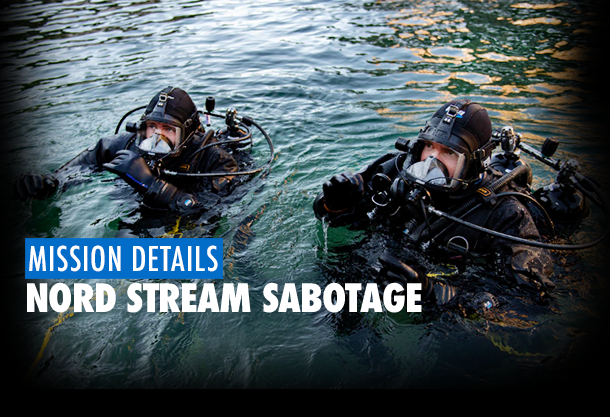 .
.
Following the very damning report entitled, “How America Took Out The Nord Stream Pipeline,” published on February 8th by the legendary investigative journalist Seymour Hersh, the US authorities are still not budging from their official denial, and refuse to admit any form of involvement with the explosion which damaged the Nord Stream pipelines on Sept 26th of last year.
As a result, Nord Stream sabotage theories deepen as shreds of evidence and intelligence leaks surrounding the sabotage of the pipelines have provided more questions than answers, with the New York Times even admitting, “It may be in no one’s interest to reveal more.”
Contrary to the mainstream media consensus of the ‘unsolved mystery’ hinting towards the tenuous official conspiracy theory, that Russia is somehow guilty of sabotaging its own pipeline project, we believe it’s very much in the public interest to expand on Hersh’s story by revealing more important details surrounding this top secret military operation carried out on the ocean floor of the Baltic Sea.
Despite their proximity to the event question, and being a primary stakeholder in the Nord Stream pipeline project, the German government has done little if anything in terms of a serious investigation into the unprecedented attack, with the German officials serving us a remake of the 9/11 story, albiet with a James Bond feel to it, involving fake Bulgarian passports and some trace of explosives on a 50-foot pleasure craft called ‘The Andromeda’. In his follow-up piece entitled, “The Cover-up,“ published on March 22nd, Hersh maintains this was a desperate cover story conjured by US intelligence in order to deflect from his bombshell revelations. According to the Germans, six men are believed to have planted C4 explosives on the seabed at a depth of 262 feet which, when detonated, triggered a blast registering 2.5 on the Richter scale. I am confident Hollywood will take full advantage of this compelling plot in combination with the even more spectacular claim from a US intelligence report suggesting that a ‘rogue’ pro-Ukrainian group carried out the attack on the Nord Stream pipelines. A blockbuster in the making, for sure.
It’s now time to fill-in the remaining gaps of Hersh’s bombshell story, and reveal the ‘secret team’ who carried out this historic attack on a vital piece of European energy infrastructure. In this article, we will show you which state actors had the means, the motive and the opportunity to carry out this crime. We will also show you the actual demolition diving team that participated in BALTOPS-22, a 13-day naval exercise which featured some 47 ships, 89 aircraft, and 7,000 personnel in the Baltic Sea, under the command of NATO Supreme Allied Commander Europe’s (SACEUR). We will also break down some of the equipment – minisubs and multi-role support vessels – used by these elite deep sea divers, whilst also identifying the various factions involved in the planning and the execution of what was a well-rehearsed and successful CIA-backed covert operation.
Seymour Hersh has stated that under the cover of BALTOPS-22, C4 explosives were attached to the pipelines, which would later be triggered by a sonar buoy dropped by a military plane. Hersh explains what happened next:
“Once in place, the delayed timing devices attached to any of the four pipelines could be accidentally triggered by the complex mix of ocean background noises throughout the heavily trafficked Baltic Sea—from near and distant ships, underwater drilling, seismic events, waves and even sea creatures. To avoid this, the sonar buoy, once in place, would emit a sequence of unique low frequency tonal sounds—much like those emitted by a flute or a piano—that would be recognized by the timing device and, after a pre-set hours of delay, trigger the explosives.”
The explosions occurred on Sept 26th, and subsequent underwater gas leaks occurred which visibly bubbled to the ocean surface (image, below).
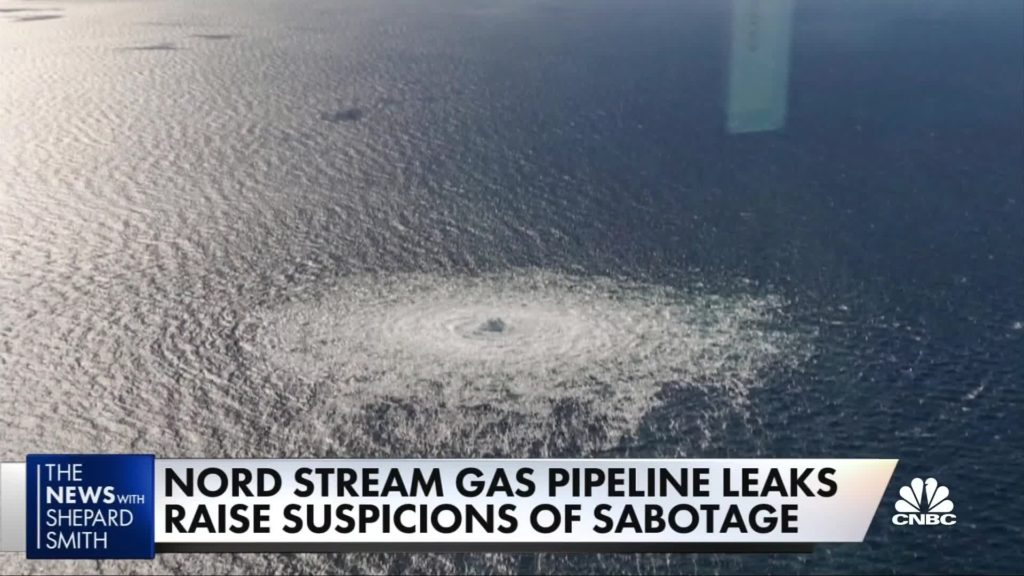
The initial story published by Seymour Hersh did open the door to a plausible explanation as to what had taken place in the Baltic Sea last autumn, but it has also left a number of unanswered questions as to the specifics of the operation. As per his confidential source, Hersh stated that US Navy divers, operating under the cover of the annual NATO exercise known as BALTOPS-22, had planted triggered explosives which were then detonated three months later, destroying three of the four pipelines in the Nord Stream 1 and 2 transit network which carries Russian natural gas to Germany. His source also replayed how this operation planning was led by Biden’s National Security advisor, Jake Sullivan, receiving input from men and women from the Joint Chiefs of Staff, CIA, State and Treasury departments. The initial meetings took place in “a secure room on a top floor of the Old Executive Office Building, adjacent to the White House, that was also the home of the President’s Foreign Intelligence Advisory Board (PFIAB).”
Soon afterwards, “[CIA director] Burns quickly authorized an Agency working group whose ad hoc members included—by chance—someone who was familiar with the capabilities of the Navy’s deep-sea divers in Panama City. Over the next few weeks, members of the CIA’s working group began to craft a plan for a covert operation that would use deep-sea divers to trigger an explosion along the pipeline.” Regarding the special diving operation, Hersh states:
“The divers were Navy only, and not members of America’s Special Operations Command, whose covert operations must be reported to Congress and briefed in advance to the Senate and House leadership—the so-called Gang of Eight. The Biden Administration was doing everything possible to avoid leaks as the planning took place late in 2021 and into the first months of 2022.”
Hersh notes that the idea of a CIA-led special operations using US Navy divers to intervene with Russia infrastructure has solid pedigree. In 1971, Operation Ivy Bells was a joint US Navy and CIA covert mission, which successfully located and wire-tapped an undersea communications cable in 400 feet of water off the coast of the Kamchatka Peninsula located some 2,300 km northeast of Vladivostok in the Russian far east region.
The Mission: Nordstream Sabotage
We believe there is value in being more precise regarding the accusation that US Navy deep sea divers were used from The Naval Diving and Salvage Training Center (NDSTC), which operates out of the Naval Support Activity base in Panama City (NSA Panama City), often referred to as one of the largest diving facilities in the world. Our interest in the subject is not new and those who follow reports on the 21st Century Wire might recall our previous article (QUI BONO? From 9/11 to Nord Stream – A New Geopolitical Game Changer). Our curiosity took us to the heart of the US Naval Sea Systems Command (NAVSEA), and its U.S. Navy research and warfare centers (NSWC PCD) in Panama City, including its Navy Experimental Diving Unit (NEDU).
This underwater demolition mission used NATO’s BALTOPS-22 as cover for this act of war, and rapidly our investigation’s attention turned towards the Norwegian Armed Forces and their close ties with NATO Joint Force Command in Norfolk Virginia (NATO JFC-NF), looking into the NATO Wargame Center there, and NATO’s Joint Logistics Support Group (JLSG) based out of Norway – to see if they too played a role in this logistically complex mission. Our findings are more than compelling.
Later, in Part 2 of this series, we will also analyse the overarching geostrategic energy play which is now underway, as evidenced by Norway’s renewed interest in the Barents Sea Pipeline gas project as part of Europe’s new Green Deal industrial plan, with its multi-pronged strategy, including long-term ambitions to create a European Hydrogen Energy market, initially involving ‘blue hydrogen’ at first, followed by ‘green hydrogen’ in the long-run. Not surprisingly, the two main partners for this project are Norway and Germany.
We must first familiarise ourselves with the overarching command structures that this operation was conducted. Let us start with the NAVSEA, currently operates eight Surface Warfare Centers:
1. NSWC Carderock, Maryland.
2. NSWC Corona, California.
3. NSWC Crane, Indiana.
4. NSWC Dahlgren, Virginia.
5. NSWC Indian Head, Maryland.
6. NSWC Panama City, Florida.
7. NSWC Philadelphia, Pennsylvania.
8. NSWC Port Hueneme, California.
NAVSEA has also seven affiliated Program Executive Offices (PEOs) including a PEO for Undersea Warfare Systems which enables the delivery of enhanced combat capability, with improved cybersecurity and resiliency, to all submarine platforms.
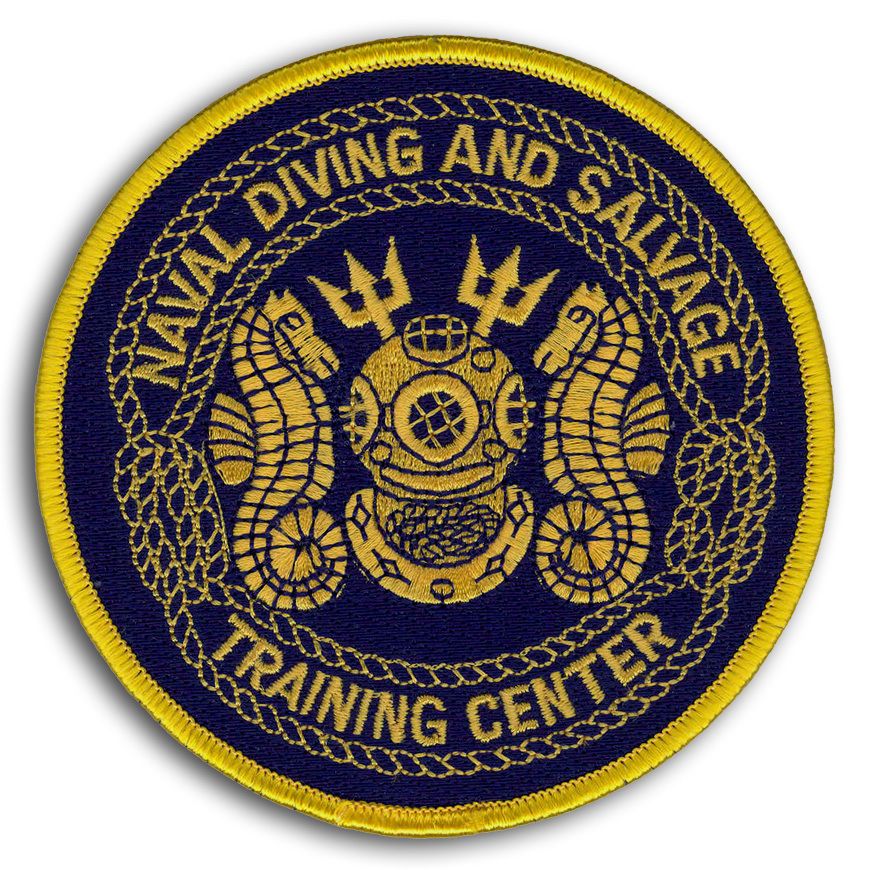 The primary mission of NSA Panama City is to provide, operate and maintain facilities, providing defence and physical security of critical infrastructures. Major tenants include Naval Surface Warfare Center-Panama City Division (NSWC PCD), Naval Diving and Salvage Training Center (NDSTC), Navy Experimental Diving Unit (NEDU) and U.S. Coast Guard Station Panama City. In a few words, the Naval Surface Warfare Center-Panama City Division is the perfect location to assemble a highly skilled special force diving team and the equipment needed to plan and conduct an underwater high-risk covert military operation.
The primary mission of NSA Panama City is to provide, operate and maintain facilities, providing defence and physical security of critical infrastructures. Major tenants include Naval Surface Warfare Center-Panama City Division (NSWC PCD), Naval Diving and Salvage Training Center (NDSTC), Navy Experimental Diving Unit (NEDU) and U.S. Coast Guard Station Panama City. In a few words, the Naval Surface Warfare Center-Panama City Division is the perfect location to assemble a highly skilled special force diving team and the equipment needed to plan and conduct an underwater high-risk covert military operation.
The NDSTC in Panama City is where the U.S. Navy trains some of its best deep-sea and saturation divers – regarded as among the elites in this category of specialised military operations. These ‘One Team Warfare Centers’ provide also training facilities for the Seabee underwater construction divers (Naval Construction Force – NCF) as well as for the joint service diving officers, including explosive ordnance disposal officers (EOD). It is truly a One Team Warfare Center.
More information of the Naval Surface Warfare Center- Panama City Division (NSWC PCD):

.
NDSTC in Panama City houses 23 certified diver life support systems, which include 6 hyperbaric recompression chambers, 2 diving simulation facilities capable of 300 feet (91 m), an aquatics training facility which is the second-largest pool in the U.S., a submarine lock-out trunk and two 133 feet (41 m) Yard Diving Tenders (YDT) for open ocean diving support (with recompression chambers and mixed gas diving capabilities). The NDSTC reports to the Center for EOD and Diving (CENEODDIVE).
The Naval Diving and Salvage Training Center (NDSTC):
The Navy’s Explosive Ordnance Disposal Divers (EOD Units) train at the Center for Explosive Ordnance Disposal and Diving (CENEODDIVE), located at the Naval Support Activity (NSA) in Panama City, Florida. Navy Expeditionary Combat Command (NECC) and U.S. Fleet Forces (USFF) and Command Individual Augmentee (IA) global force management team are responsible for sustaining the Navy Expeditionary Combat Force (NECF) to execute combat, combat support, and combat service support missions across the full spectrum of naval, joint, and combined operations. It looks like we are at the right place.
EOD Units such as EODMU 6 have been reported to operate out of Panama City, this unit is assigned to Explosive Ordnance Disposal Group Two (EODGRU TWO), a critical part of the Navy Expeditionary Combat Force (NECF) that conducts “improvised explosive devices” (IED) operations, renders safe explosive hazards and disarms underwater explosives such as sea mines. EOD specialists can handle everything from chemical, biological and radiological threats and are the only military EOD force that can both, parachute from the air to reach distant targets or dive under the sea to disarm weapons. EOD’s Mobile Diving and Salvage Units clear harbors of navigation hazards, and engage in underwater search and recovery operations. EOD technicians handle foreign, domestic, and homemade explosives.
 According to the U.S. Naval Forces Europe and Africa/U.S. Sixth Fleet, Explosive Ordnance Disposal Mobile Unit 8 (EODMU 8) which works under the Navy Expeditionary Combat Task Force Europe-Africa/Task Force 68 (NECFEURAF/TF 68 or CTF 68), they are responsible for assembling demolition operations, providing explosive ordnance disposal operations, naval construction, expeditionary security and theatre security efforts to Naval Forces Europe-Africa and U.S. 6th Fleet (source).
According to the U.S. Naval Forces Europe and Africa/U.S. Sixth Fleet, Explosive Ordnance Disposal Mobile Unit 8 (EODMU 8) which works under the Navy Expeditionary Combat Task Force Europe-Africa/Task Force 68 (NECFEURAF/TF 68 or CTF 68), they are responsible for assembling demolition operations, providing explosive ordnance disposal operations, naval construction, expeditionary security and theatre security efforts to Naval Forces Europe-Africa and U.S. 6th Fleet (source).
EOD Mobile Unit 8 ( EODMU 8) and attached EOD platoons like EOD Units (EODMU6) provide critical and unique EOD, diving, mine countermeasures, and mobility capabilities that render safe conventional munitions, improvised explosive devices (IED), and weapons of mass destruction (WMD).
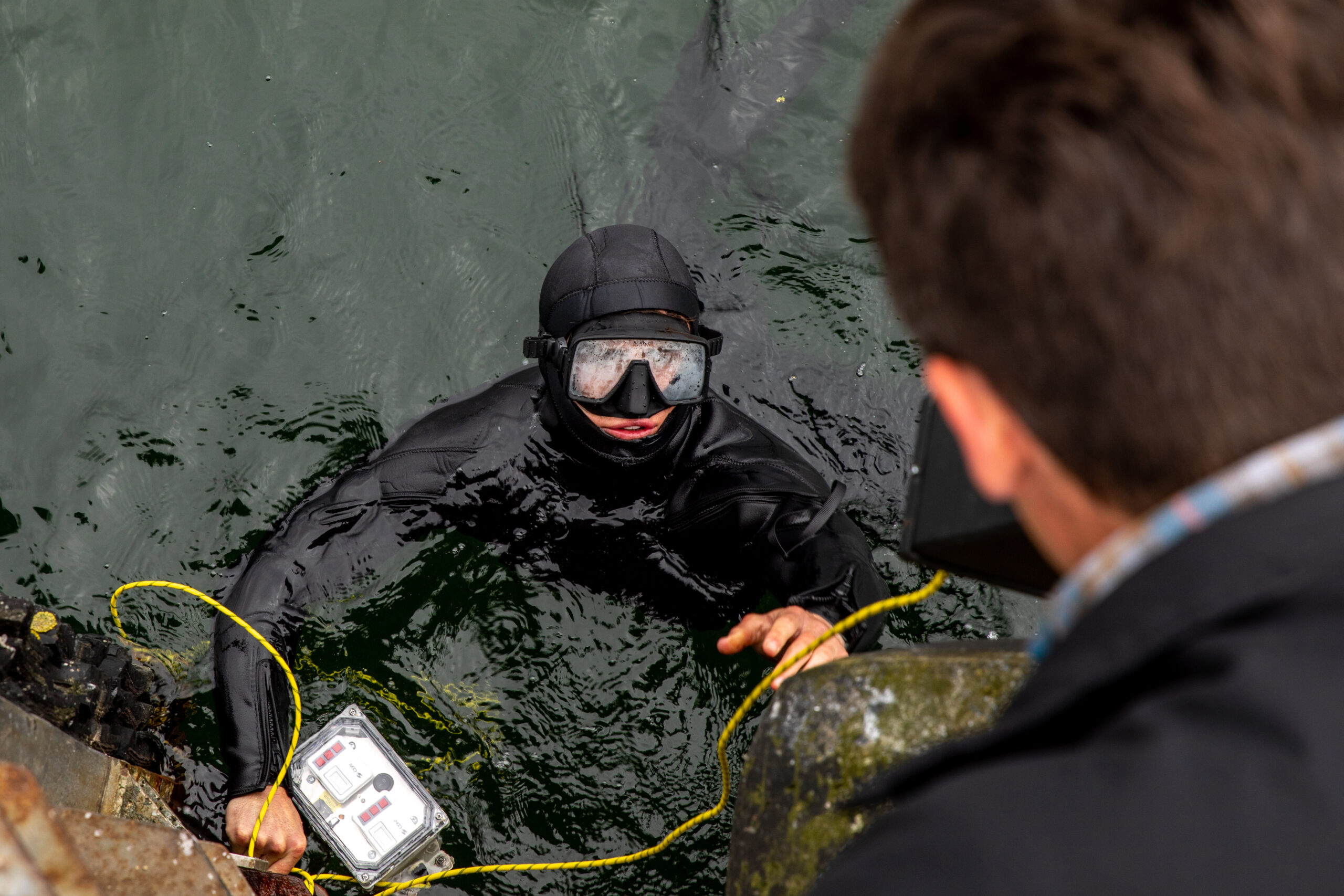
IMAGE: Lt. j.g. Chris Bianchi, assigned to Explosive Ordnance Disposal Mobile Unit EODMU 8, prepares mock explosives for a pier-side training event during exercise BALTOPS 22 (source)
 Explosive Ordnance Disposal Group Two (EODGRU TWO) routinely work with the U.S. Secret Service, CIA and the U.S. State Department, helping to protect the President, Vice President and other state and foreign officials and dignitaries. They support the U.S. Department of Homeland Security, U.S. Customs Office, and the FBI as well as state and local police bomb squads. EOD technicians also assist in security at large international events. They are on-call and always at the ready for any mission.
Explosive Ordnance Disposal Group Two (EODGRU TWO) routinely work with the U.S. Secret Service, CIA and the U.S. State Department, helping to protect the President, Vice President and other state and foreign officials and dignitaries. They support the U.S. Department of Homeland Security, U.S. Customs Office, and the FBI as well as state and local police bomb squads. EOD technicians also assist in security at large international events. They are on-call and always at the ready for any mission.
It’s important to note that EOD Group Two is headquartered at Naval Amphibious Base Little Creek, Norfolk, Virginia around the corner (2.5 mil) from NATO Joint Force Allied Command Transformation (ACT), headquarters in Norfolk Virginia (JFC-NF), the very facility which also supervises and lead Trans Atlantic joint forces warfare centres and other NATO logistics hubs and missions in northern Europe and the Baltic/Arctic, which would include BALTOPS exercises.
Strangely (or not), the Commander of NATO’s Joint Warfare Centre in Europe is a two-star General, based in Stavanger, Norway, falling under the pillar of the three-star DCOS Joint Force Trainer based at Allied Command Transformation (ACT) in Virginia, Norfolk, United States.
The list of military special operation units harboring top experts divers with special training in underwater demolition is rather short, and therefore the only place left to look into is the Joint Special Operations Command (JSOC) which commands and controls the Special Mission Units (SMU) of U.S. Special Operations Command (USSOCOM). These units perform highly classified operations and accomplish high-risk, politically-sensitive missions with a low signature and small footprint. The Group for Specialized Tactics, also known as the “Ghosts” are an elite Special Mission Units within JSOC, with a chain of command stretching right up to the President of the United States.
Not all of these units are known to the public due to the classified nature of their missions; however, the SEAL Team Six from The United States Naval Special Warfare Development Group (NSWDG) previously known as DEVGRU, is a U.S. Navy component of Joint Special Operations Command and are known to be recruited for special operation for the CIA, including advanced underwater demolition missions and they would certainly qualify as relevant for a Nord Stream pipeline sabotage mission in the Baltic Sea. More on the Naval Special Warfare Development Group, SEAL Team 6 in this article by The Intercept.
JSOC has a close relationship with the CIA’s elite Special Activities Division (SAD) and the two forces often operate together. The SAD’s Special Operations Group often selects their recruits from the JSOC. This is important to note in conjunction with Seymour Hersh’s reporting that the Nord Stream sabotage was a CIA-led operation.
The joint statement made by General Richard D. Clarke commander of US Special Operations Command (USSOCOM) before the 117th Congress Senate Armed Services Committee on April 5, 2022, refers extensively to the Ukraine-Russian conflict. In his statement, General Clarke refers to his Special Operations Forces (SOF) as “The Problem-Solvers”. How prescient.
Furthermore, the U.S. Special Operations Command is very keen on bringing under its umbrella the latest underwater technology and systems which they procure for their Navy SEAL teams. It is with this special class of equipment that the Nord Stream mission could be carried out with absolute precision.
One of their most interesting recent acquisitions is the ‘S351 “Nemesis‘ designed by USSOCOM and MSUBS, a British company operating out of Plymouth, UK. MSUBS is wholly owned by Submergence Group LLC, a Texas-based company which provides the linkages into the United States DOD and is responsible for contract support, most notably operator training. The ‘Nemesis’ sub is a Dry Combat Submersible (DCS) with extraordinary capacities that can take a team of divers to a depth of 330 feet (100 Meters), transporting a crew made of a pilot and a co-pilot/navigator, and eight fully-equipped SEALs and/or other payloads items up to 1.1 tonnes in weight. The mission endurance of this unique DCS is greater than 24 hours, and likely more. Indeed, Lockheed Martin has partnered with Submergence Group to build, integrate and test three undersea transport vehicles from MSUBS for USSOCOM.
Because of the above-mentioned links, we strongly believe that the divers Seymour Hersh mentioned in his report could have been using the S351 Nemesis for their Mission off the coast of Denmark Bornholm island. See more info here.
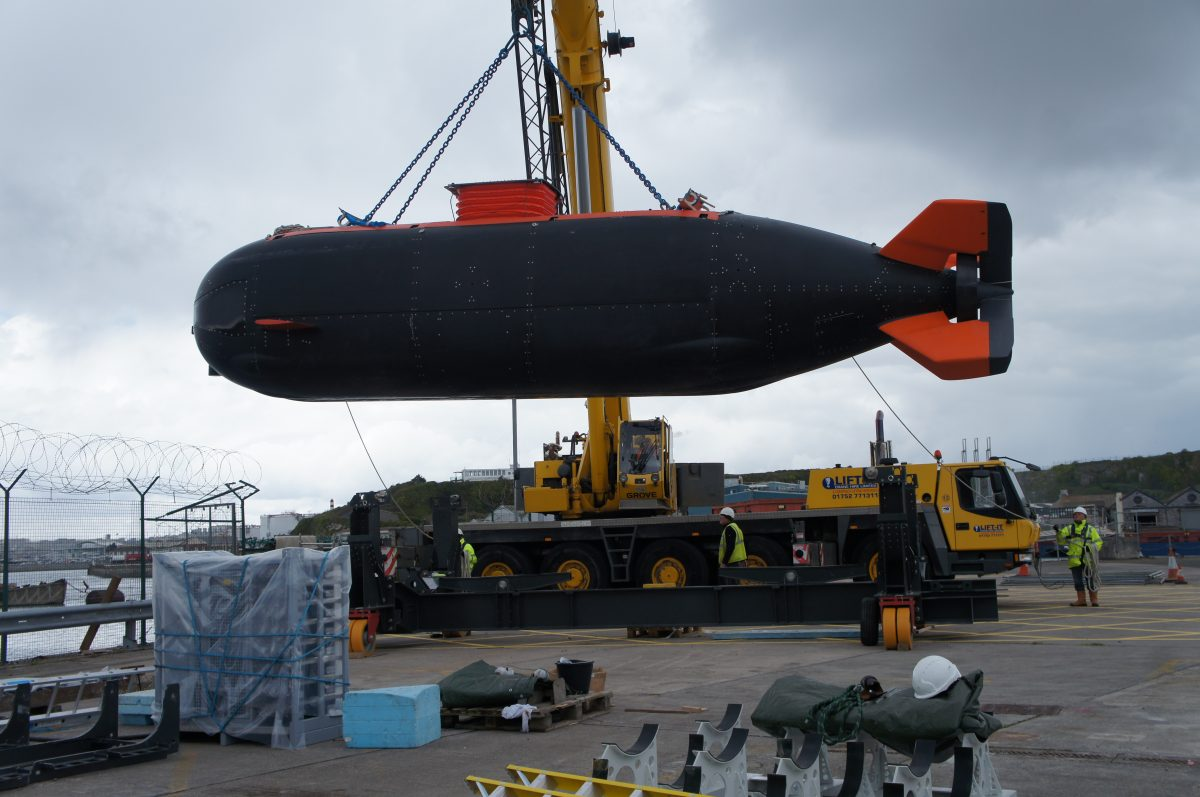
IMAGE: USSOCOM Dry Combat Submersible S351 Nemesis, by the Submergence Group/MSUBS.
This is what the Special Forces Navy SEALs were using before Dry Combat Submersible came into play.
Underwater Infiltration: SEAL Delivery Vehicle (SDV) video:
Undercover of BALTOPS: Nordstream Mission Support Ship
In the following PDF document, we resume some of the key details regarding the British Royal Navy’s involvement in BALTOPS-22 as well as the ‘Joint Viking‘ March 2023 large-scale land and sea exercise which took place in Norway. We have isolated two major contenders for sea vessels which tactically and technically qualify for the transportation of a Dry Combat Submersible for the Navy SEALS to carry out a covert underwater diving and demolition expedition in the Baltic Sea. Enter these two British Royal Navy multi-role ships:
- HMS Defender
- HMS Albion

Will also look into the Future Autonomous at Sea Technologies FAST Cluster run out of Plymouth, southwest of England, that could provide all the required facilities to train and test MSUBS DCS ahead of BALTOPS-22.

.
Perfidious Albion?
Many have already forgotten UK former Prime Minister Liz Truss’s infamous “It’s Done” SMS to US Secretary of State Antony Blinken just minutes after the Nord Stream blasts, and yet, this very revealing SMS indicates a UK awareness and very likely co-involvement in what Hersh describes as a CIA covert operation that led to the Nord Stream Pipeline sabotage. As members of the Five Eyes intelligence alliance, and as NATO members, British and the US, along with its foreign intelligence arms MI6 and CIA, are known to have been working together for years on numerous covert operations in the Middle East and numerous other locations, and so this shouldn’t come as a surprise to anyone. Despite the many calls for a UK government investigation into the matter, no official explanation was ever provided. This is unbelievable considering the international ramifications of this incident.

IMAGE: Liz Truss phone hack and SMS claim prompts calls for investigation (Source: BBC)
Diving Deep into the World of Manned or Unmanned Underwater Vehicles
It’s important to cover all of the likely participants in this kind of undersea operation. Which also brings us to Huntington Ingalls Industries, a world leader in Unmanned Underwater Vehicles (UUV), who in April 2016 announced that PROTEUS, the dual-mode undersea vehicle developed by the company’s subsidiary and Battelle, had successfully completed endurance testing that month.
The 30-day simulated unmanned mission was performed in a test tank at Undersea Solutions Group (USG) at the Panama City, Florida facility, to demonstrate the Unmanned Underwater Vehicle’s reliability and ability to perform long-duration missions with the US Navy’s future Dual-mode underwater vehicles (source). The mission capabilities of the PROTEUS underwater vehicle include inspection of undersea infrastructure, integration and testing of payload systems, installation of equipment on the ocean floor, autonomy development, and long-range and duration trials.
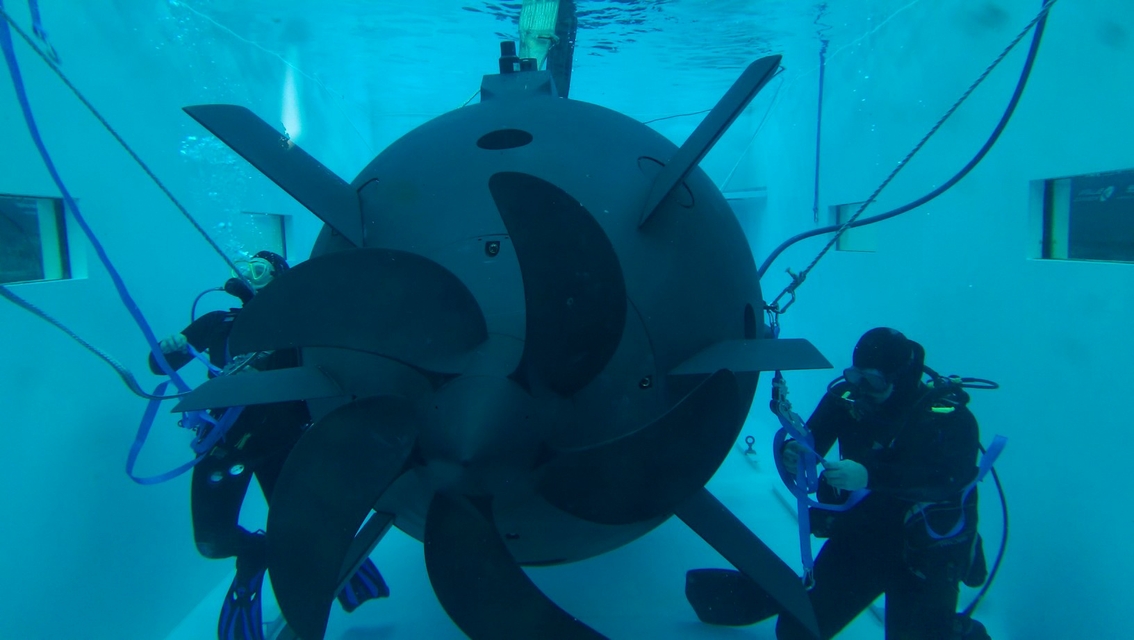
IMAGE: Proteus UUV tested with Divers in Panama City Florida (source)
HII’s technical solutions division and Battelle/Bluefin jointly developed PROTEUS.
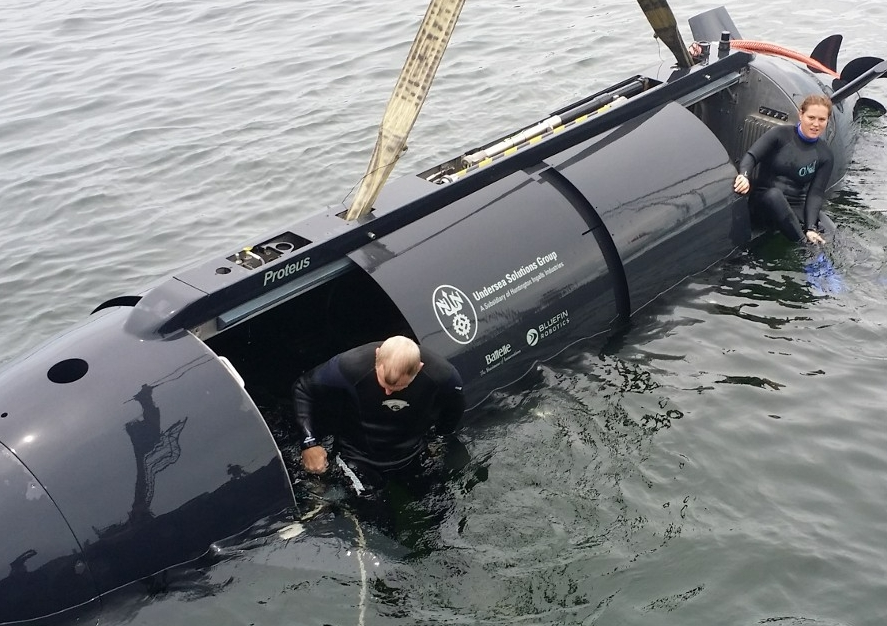
IMAGE: PROTEUS Dual-mode underwater vehicle (DMUV) taken out for a test in Florida’s Saint Andrews Bay – USG Vice President Ross Lindman as the pilot is preparing to crew and drive the Proteus dual-mode underwater vehicle. Photo by Joe Colamaria/HII (source).
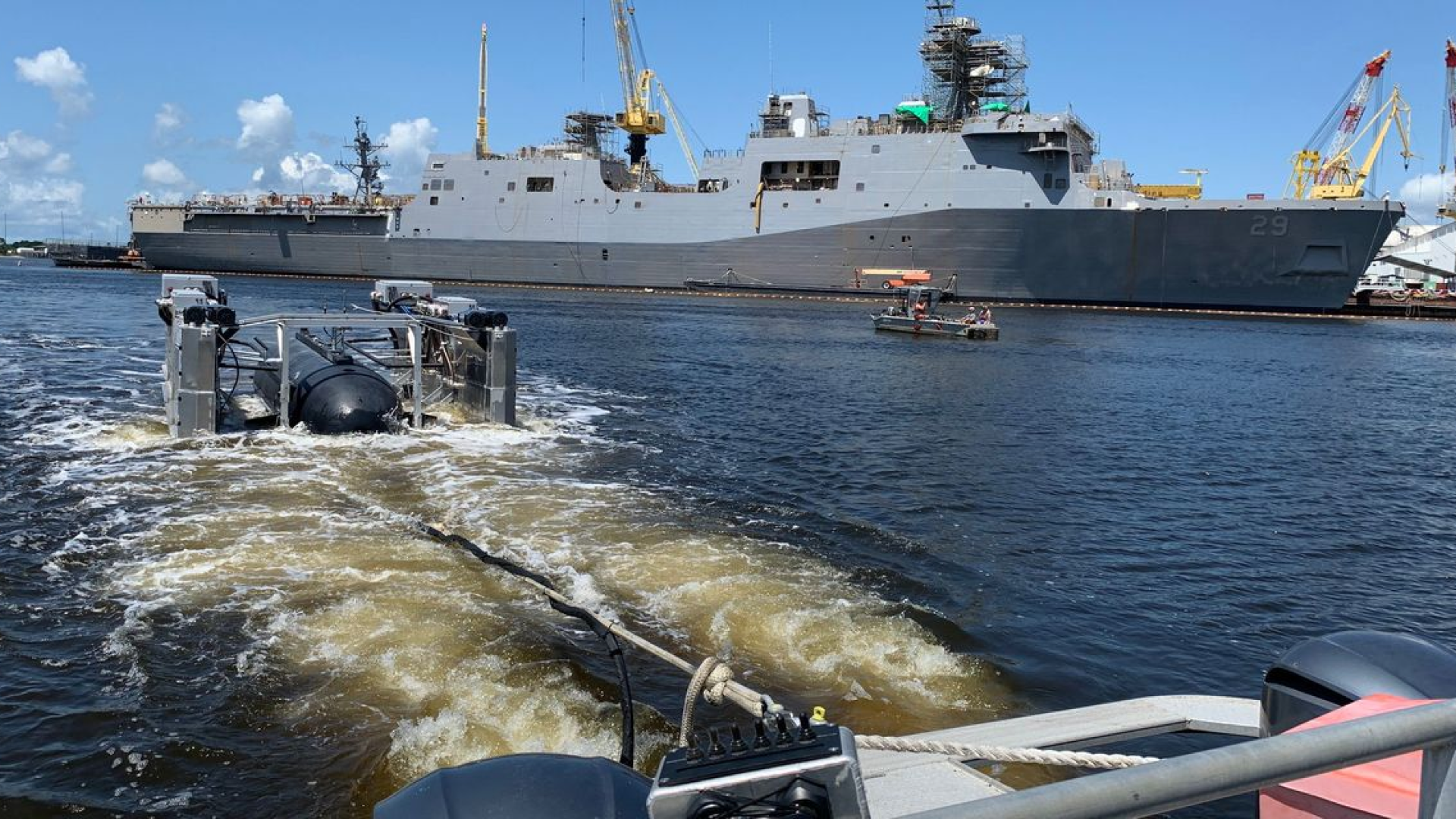
IMAGE: HII’s Pharos prototype platform being towed behind a small craft in the Pascagoula River while recovering HII’s Proteus LDUUV.
Again, we should note that the Undersea Solutions Group operating out of Panama City has developed the dual-mode undersea vehicle with US Department of Defense contractor Battelle-Bluefin.
The follow are Battelle’s technical specs for the PROTEUS:

.
About Undersea Solutions Group
Undersea Solutions Group (USG) develops and builds specialised manned and unmanned undersea vehicles for military customers around the world. USG has built or converted specialised craft for a variety of purposes – including support of submersibles and submarines, special warfare, testing of mine warfare systems, torpedo countermeasures and more. Originally established in 1972, USG operates in Panama City Beach, Florida, and reports to HII’s Newport News Shipbuilding division.
About HUNTINGTON INGALLS INDUSTRIES (HII) and HYDROID INC.
In March 2020, Huntington Ingalls Industries (HII) announced they had closed on the acquisition ($80 million) of Hydroid Inc, a subsidiary of Kongsberg Maritime a division of the Kongsberg Gruppen, the famous Norwegian global defense contractor and provider of advanced marine robotics and systems to the defense and maritime markets.
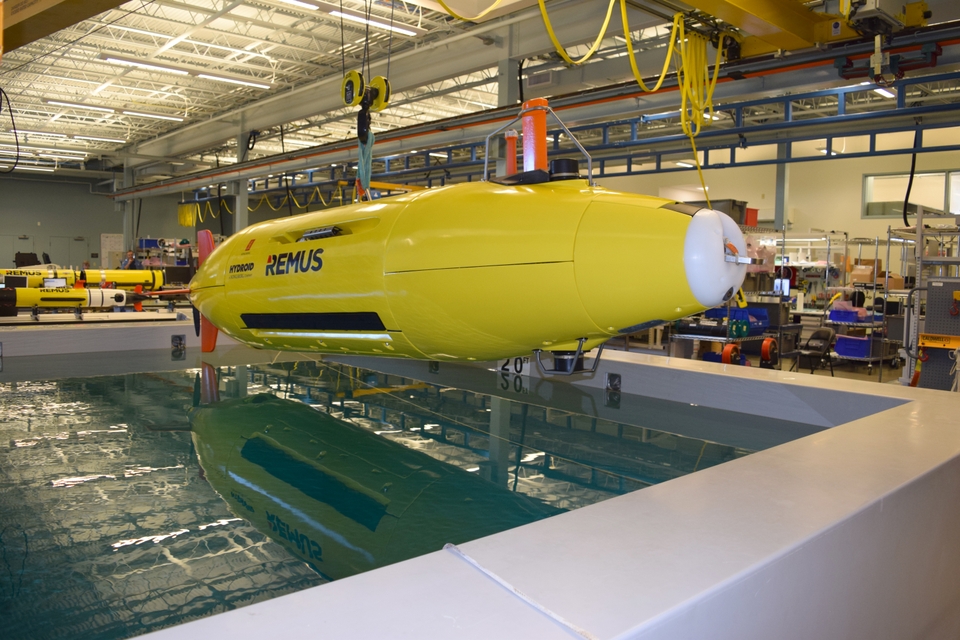
IMAGE: Hydroid Inc Unmanned Underwater Vehicles REMUS.
In conjunction with the transaction, HII and Norwegian defense contractor Kongsberg Maritime have established a strategic alliance to jointly market naval and maritime products and services to the U.S. and global market .
It’s important to highlight that during BALTOPS-22, current and future programs for mine-hunting UUVs such as the Navy Mk18 and Lionfish systems program where these UUVs have emerged from, were tested and used over 10 days of mine-hunting operations, collecting over 200 hours of undersea data.
HII UUV product lines and equipment include:
• REMUS (Hydroid)
• Seaglider
• Proteus (USG)
• UUV Auxiliary Equipment
• Launch and Recovery Systems
• Subsea Docking and Infrastructure
In Seymour Hersh’s report, we learned that divers would have had to dive as deep as 260 feet, possibly from a Norwegian Alta class mine hunter ship, placed just a few miles off Denmark’s Bornholm Island coast. The Alta are mine sweepers and they, as far as we are aware, were not officially listed as participants in BALTOPS-22, which opens the possibility that it might have been the Oksøy-Class mine hunter, or another NATO member multi-role support ship – both of which could invalidate Hersh’s source information, an important detail that still needs to be resolved.

IMAGE: Norwegian М314 Alta Class Minesweeper, Oslo (source), developed in the fifties in the United States under the US military assistance program to European partners in NATO.
Let us also take a brief look at some of the other NATO naval vessels active in the area, which will demonstrate the wide array of capabilities present during BALTOPS-22.

IMAGE: Oksøy-Class mine hunter Hinnøy who participated in BALTOPS-22 (source)
The nature of the Nord Stream mission implies that the divers chosen would have had to be experienced deep sea divers, or perhaps even saturation divers also known as “Sat Divers” who uses HeO2 (Heliox) mix. It also implies a decompression time averaging 3 hours. This could also mean that the United States Navy Experimental Diving Unit (NEDU or NAVXDIVINGU), the primary source of diving and hyperbaric operational guidance for the US Navy, located within the Naval Support Activity Panama City in Panama City Beach, Bay County, Florida – could have been involved from a consulting if not from an operational support point of view, too.
NADU is made of Explosive Ordnance Disposal Navy divers and Special Forces and more… They perform difficult tasks in dangerous underwater environments (Image source).
BALTOPS-22: Covert operations under the cover of research and testing new technology
Exercise Baltic Operations (BALTOPS) 22 is NATO’s ‘premier maritime-focused exercise in the Baltic region’ and it began on June 5, 2022, in the Baltic Sea. With a significant focus of BALTOPS every year being the demonstration of NATO mine-hunting capabilities, the U.S. Navy has traditionally use the exercise to field-test its new technology. In support of BALTOPS 22, the U.S. Navy Sixth Fleet and Naval Striking and Support Forces NATO (STRIKFORNATO) under the command of Royal British Navy Rear Adm. James Morley, partnered with U.S. Navy Research and Warfare Centers (NSWC) from Naval Sea Systems Command (NAVSEA) – whose center happens to be located in Panama City in Florida – exactly where according to Seymour Hersh, the divers and equipment for the Nord Stream Pipelines sabotage were coming from.
Again, NAVSEA will use BALTOPS to showcase all the latest advancements in Unmanned Underwater Vehicle (UUV) mine-hunting gear in the Baltic Sea and demonstrate the vehicle’s effectiveness in operational scenarios.
Note how NATO reported the Royal Norwegian Navy Skjold-Class Corvette HNoMS Glimt (P964) was sailing in formation in the Baltic Sea on June 6, 2022, during exercise BALTOPS-22, which confirms unequivocally that Norway was participating in BALTOPS-22.
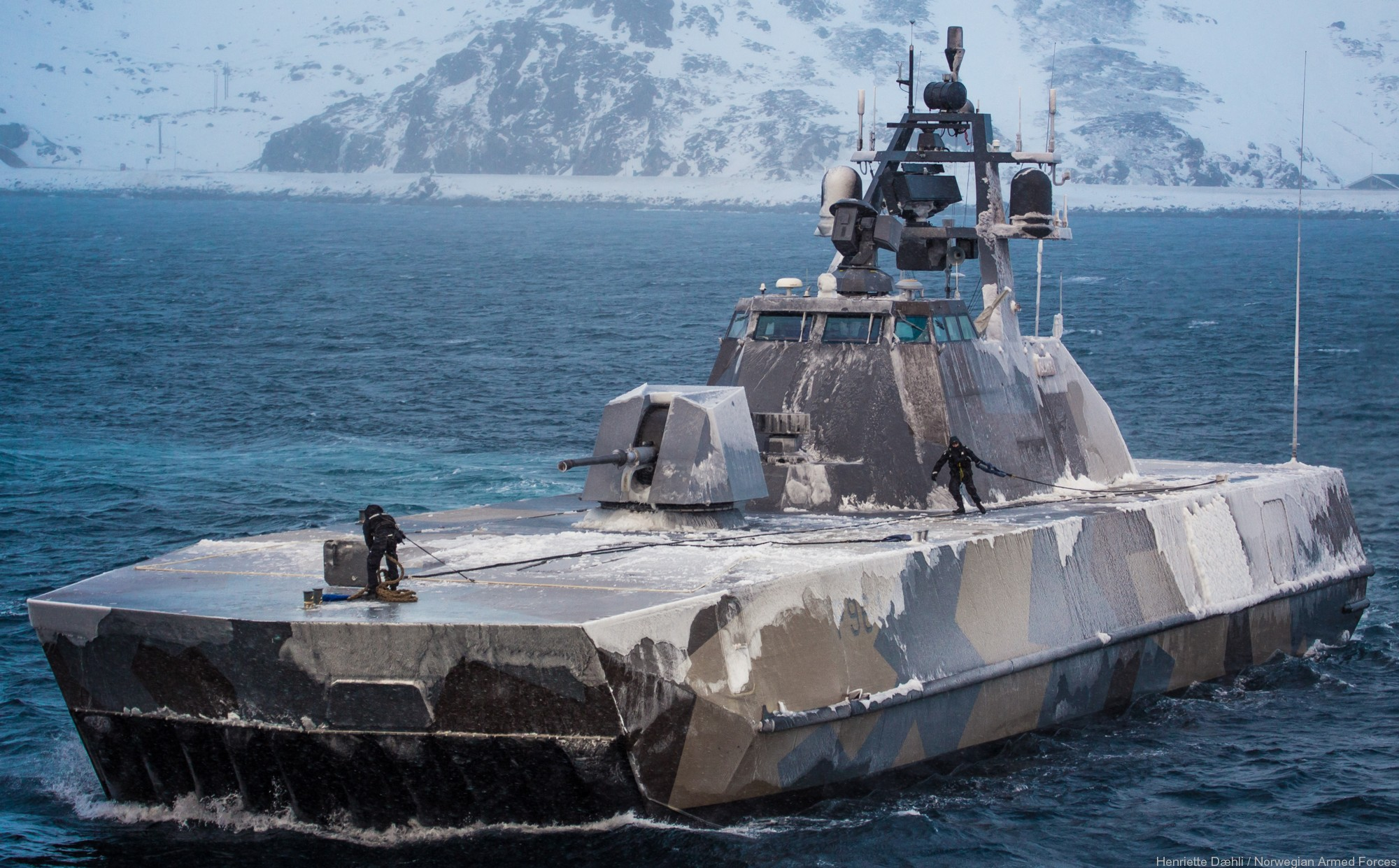
IMAGE: Royal Norwegian Navy Skjold-Class Corvette HNoMS Glimt (P964)
Norway takes the lead on NATO logistics in the Nordic areas
Like in any military operation, logistics play a key role in the success of a mission with a predetermined point of entry and a well-thought-out exit strategy. Understanding Norway and NATO logistical partnership in relation to BALTOPS-22 is essential and the first step was for us to determine if any joint partnership agreements between these two organisations were put in place and signed.
NATO has several commands in Europe, including one in Brunssum in the Netherlands (NATO JFC Brunssum), but also one in Naples, Italy (NATO JLSG). Both of these commands have their own logistics management, the so-called Joint Logistics Support Group (JLSG), so it was important to understand if Norway, which already cooperates with both above-mentioned command’s establishment, was working with NATO JFC in Norfolk Virginia, USA, toward creating a Norwegian Joint Logistics Support Group – and indeed they were.
Interestingly enough, by digging a little bit further, we were able to confirm that since 2020, the Norwegian Armed Forces have been working together with NATO Joint Forces Command Norfolk (JFC NF, USA) towards establishing a Norwegian Joint Logistic Support Group which became known as “NOR JLSG.”
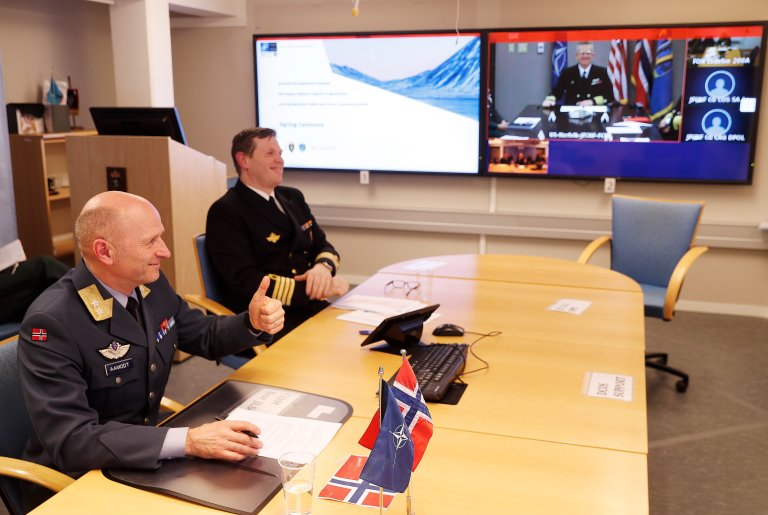
IMAGE: Chief of the Norwegian Armed Forces’ logistics organisation, Major General Lars Christian Aamodt (tv) signing the agreement with NATO JFC in Norfolk via video link. Right: project manager for NOR JLSG, Commander Remi Jakobsen (source)
Here is the NOR JLSG meeting with Joint Logistics Support Group Brunssum in the Netherlands:
JLSGBS HQ welcomes the visitors of the Norwegian JLSG HQ!
Brigadier-General Anders Jernberg and Captain Remi Jakobsen met and spoke with many of the JLSGBS staff members. A great opportunity to share knowledge, experiences and other information, and to strengthen the cooperation. pic.twitter.com/Xd28YyQCTz— Joint Logistics Support Group Brunssum (@JBrunssum) February 21, 2022
NATO JFC Norfolk serves as NATO’s operational bridge between Europe and North America.
The Norwegian Armed Forces logistics organisation also known as NDLO started small before gradually building up its operation and competence skills to become both a National Logistics Operations Center (NLOGS) in Norway but also one of NATO Joint Logistics Support Group (JLSG) headquarters for NATO Joint Force Command Norfolk, USA (JFC NF). Four months prior to the BALTOPS-22 naval exercise, NATO Joint Force Command Norfolk (NATO JFC-NF Virginia, USA) signed a technical agreement (source) in February 2022 with the Norwegian Armed Forces’ logistics organisation (NDLO).
The signing of this Technical Agreement was all about solidifying NATO JFC Norfolk’s ambition to establish a Joint Logistic Support Network (JLSN) in Norway. Clearly, the NOR JLSG fusion operation was created to strengthen the logistics required to execute NATO activity in the High North. This Joint Logistic Support Network (JLSN) consists of but is not limited to points of debarkation, lines of communication, logistic bases, convoy support centres, staging areas and forward logistics sites. All of this is required to successfully execute the Nord Stream mission.
Furthermore, the Norwegian Armed Forces benefit from a state-of-the-art Joint Headquarters in Bodø, northern Norway, which operates 24–7 and has the overall command and control of all military activity in Norway. It also commands the Norwegian military personnel abroad. However, it would appear that communications during international live exercises such as BALTOPS-22, which would have involved the Norwegian Armed Forces participating in the NATO exercise, were coordinated not only via this Joint Headquarters, but by a smaller NATO NCI Agency CSU support unit in Stavanger, Norway where the NATO Joint Warfare Center (JWC) in Norway is located.
This CSU Support unit was created to ensure NATO Allied Command Transformation (ACT), NATO headquarters in the United States remains connected to its oversea counterparts at all time, especially during large-scale exercises. NATO NCI Agency CSU support unit in Stavanger, Norway provides constant commutation during exercises including extensive support to the US Navy fleet during training and exercise such as BALTOPS-22 (source: P19).

IMAGE: NATO NCI Agency CSU support unit in Stavanger, Norway at NATO Joint Warfare Center (JWC) in Stavanger, Norway.
NATO Joint Warfare Centre (JWC) in Stavanger, Norway is also very much involved in the development and conceptualisation of wargames through various capability development initiatives as presented here below by Commander, Rear Admiral Jan C. Kaack, who was opening the execution phase for NATO Joint Warfare Centre (JWC) in Norway, new Wargame capability development initiative back in June 2020.
What these details reveal is that Norway is now Washington’s key NATO partner in northern Europe, and would be intimately involved in a crucial operation such as the Nord Stream mission. However, it is also essential to establish if Norway could have supported an Under Water Demolition mission and for that, the obvious place to look to was the Norwegian DOD contractor and world leader in manned and unmanned UnderWater systems, Kongsberg Maritime.
Coincidentally, Kongsberg Maritime sold its Under Water vehicle division Hydroid Inc for USD $350 million to Huntington Ingalls Industries (HII), whilst forging an alliance to provide future solutions to the US Navy. For reference, Kongsberg Maritime was contracted to deliver four complete Hugin autonomous underwater vehicle (AUV) systems to the Norwegian Armed Force through the Norwegian Defence Materiel Agency (NDMA) back in March 2017.
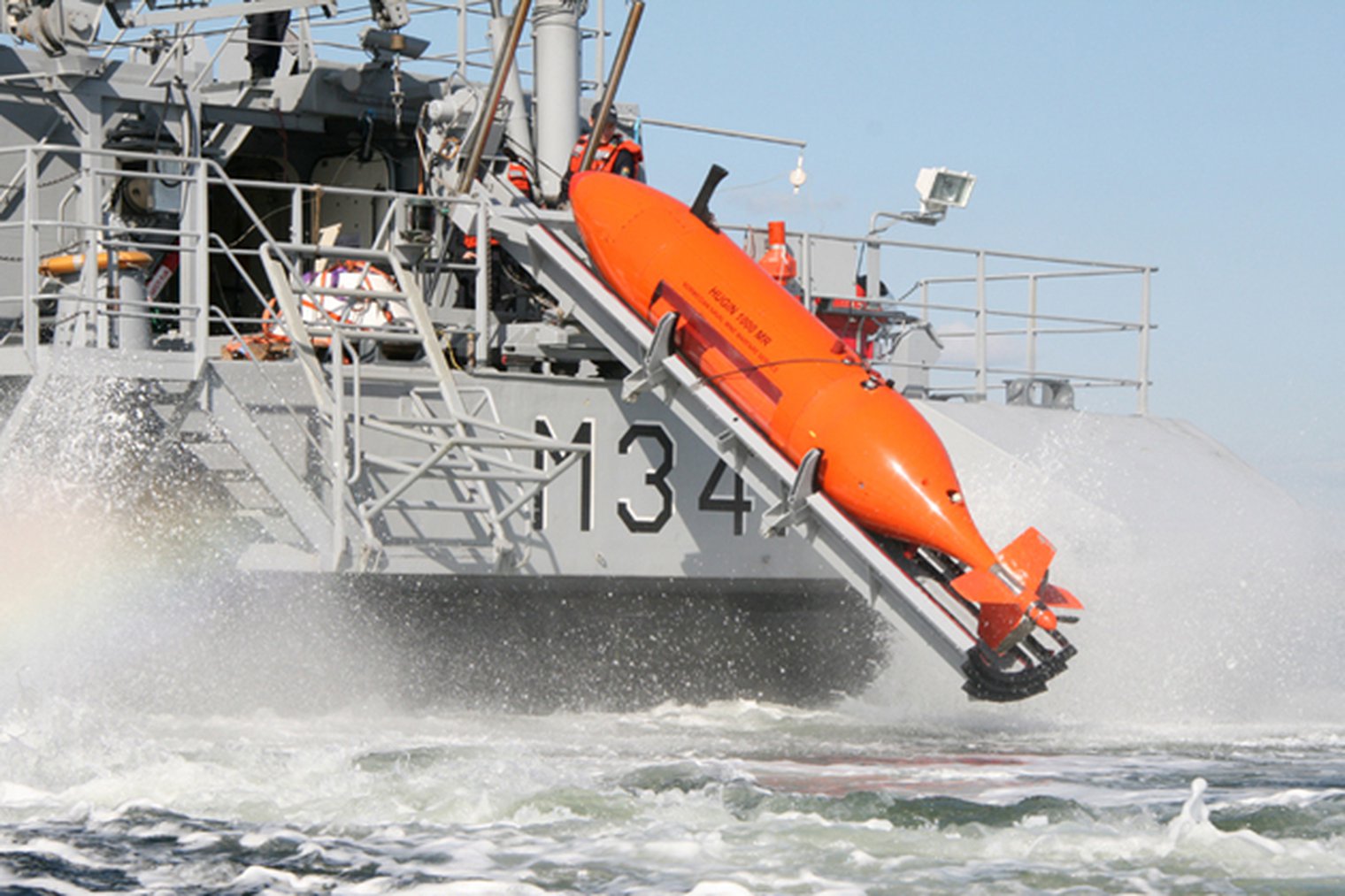
IMAGE: Norwegian Armed Forces testing their new Hugin Autonomous Underwater Vehicle (AUV) from Kongsberg Maritime. (source). The Oksøy class M341 Karmøy below was reported to have been scrapped prior to 23 July 2022.
It seems many of those investigating the Norwegian Navy and their potential involvement in the Nord Stream pipeline sabotage operation have come to a dead end, and often arrive at a conclusion in direct contradiction with Seymour Hersh’s report. Why is that?
Although it would make sense to have the Norwegian Navy putting some sweat into this covert underwater operation, since together with their Polish counterparts, they have directly benefitted from this act of sabotage, and were not shy to announce the day after the Nord Stream blasts, on Sept. 27, 2022, the opening of their new Norway-Poland Baltic gas pipeline, a key move to cut energy dependency on Russia, or rather, cornering the EU gas market along with the United States. Hence, it forces us to look at Norway as a stakeholder partner in this clandestine affair, and a key enabler – providing logistics support to the secret mission. Just as the entire western mainstream media and political class have played dumb in pointing the finger at the United States for this act of international terrorism, it would also be a mistake to ignore the motive, means and opportunity of Norway in this crime scene.
Conclusion
This ongoing investigation seems to lead us towards a joint covert operation between NATO allies the US, Norway and UK, and in Part 2 we will provide more details about the likely behind the scenes planning and execution of the Nord Stream pipeline sabotage.
The wider geopolitical and energy context is also important. In October 2022, in the wake of the Nord Stream pipeline sabotage, EU President Ursula Von der Leyen presented her new 5-point plan for “resilient critical infrastructure”, known as the CER Guidelines which replaced the European Critical Infrastructure Directive of 2008. The key elements of these CER Guidelines were: ‘enhancing preparedness; working with Member States with a view to stress test their critical infrastructure, starting with the energy sector and then followed by other high-risk sectors; increasing the response capacity in particular, through the Union Civil Protection Mechanism; making good use of satellite capacity to detect potential threats; and strengthening cooperation with NATO and key partners on the resilience of critical infrastructure.’ These new rules are meant to strengthen the resilience of critical infrastructure against a range of threats, including natural hazards, terrorist attacks, insider threats, or sabotage. A total of 11 sectors will be covered: energy, transport, banking, financial market infrastructures, health, drinking water, wastewater, digital infrastructure, public administration, space and food. Member States will need to adopt a national strategy and carry out regular risk assessments to identify entities that are considered critical or vital for society and the economy. Member states have 21 months to transpose both directives into national law.
Is all of this, timed with the destruction of the Nord Stream pipeline, a coincidence?
Never let a good crisis go to waste, right? Brussels certainly didn’t.
All they had to do was to plan a crisis with their NATO partners, blame the country who actually suffered from their actions, and later on offer the solution to the problem, all the while with Germany looking the other way, and with US/UK/Norway axis believing they actually got away with it.
NOTE: Keep your eyes peeled for Part 2 where we will demonstrate why Norway and Germany are staying silent about the Nord Stream pipeline sabotage. We will also reveal more details about the military flight which dropped the sonar buoy triggering the detonation, and the at-sea presence of the various actors who covertly planned and executed this terrorist attack on one of Europe’s most vital pieces of infrastructure for energy stability.
READ MORE UKRAINE NEWS AT: 21st Century Wire Ukraine Files
************
Source

••••
The Liberty Beacon Project is now expanding at a near exponential rate, and for this we are grateful and excited! But we must also be practical. For 7 years we have not asked for any donations, and have built this project with our own funds as we grew. We are now experiencing ever increasing growing pains due to the large number of websites and projects we represent. So we have just installed donation buttons on our websites and ask that you consider this when you visit them. Nothing is too small. We thank you for all your support and your considerations … (TLB)
••••
Comment Policy: As a privately owned web site, we reserve the right to remove comments that contain spam, advertising, vulgarity, threats of violence, racism, or personal/abusive attacks on other users. This also applies to trolling, the use of more than one alias, or just intentional mischief. Enforcement of this policy is at the discretion of this websites administrators. Repeat offenders may be blocked or permanently banned without prior warning.
••••
Disclaimer: TLB websites contain copyrighted material the use of which has not always been specifically authorized by the copyright owner. We are making such material available to our readers under the provisions of “fair use” in an effort to advance a better understanding of political, health, economic and social issues. The material on this site is distributed without profit to those who have expressed a prior interest in receiving it for research and educational purposes. If you wish to use copyrighted material for purposes other than “fair use” you must request permission from the copyright owner.
••••
Disclaimer: The information and opinions shared are for informational purposes only including, but not limited to, text, graphics, images and other material are not intended as medical advice or instruction. Nothing mentioned is intended to be a substitute for professional medical advice, diagnosis or treatment.




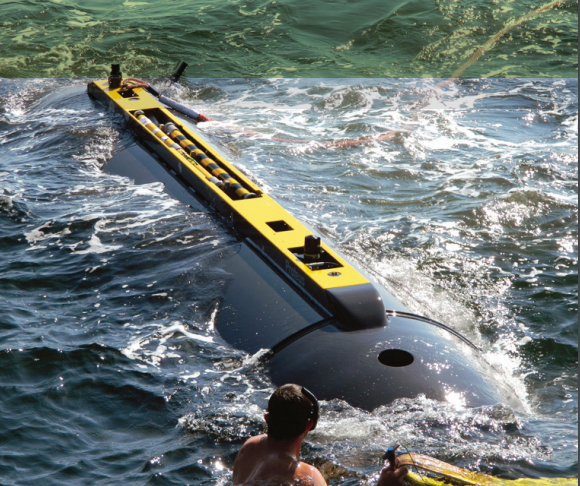


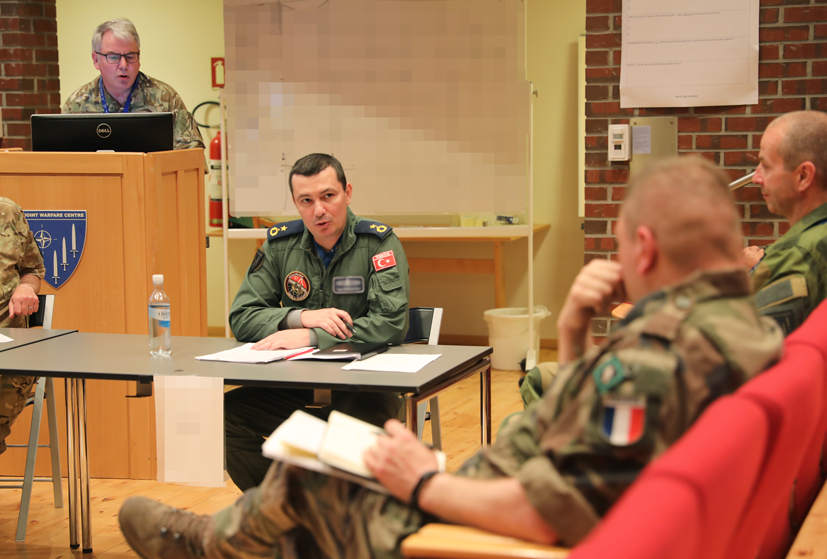



Leave a Reply